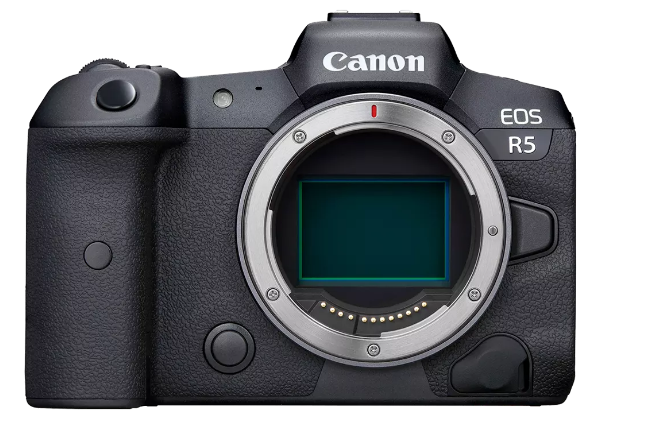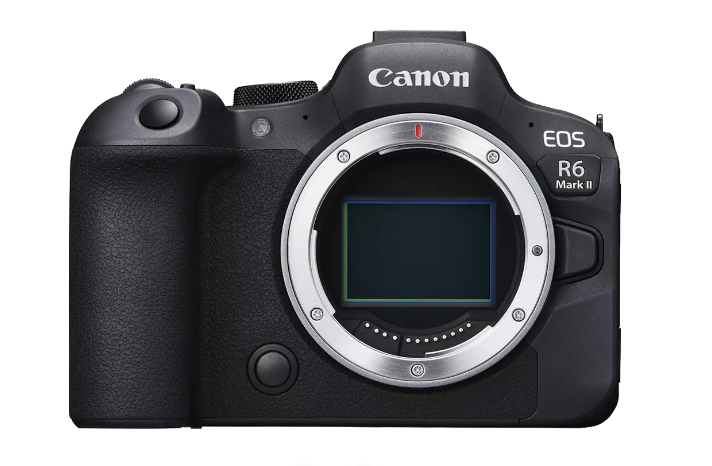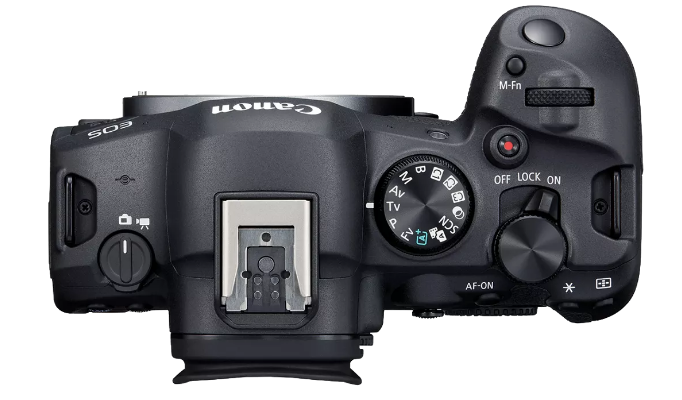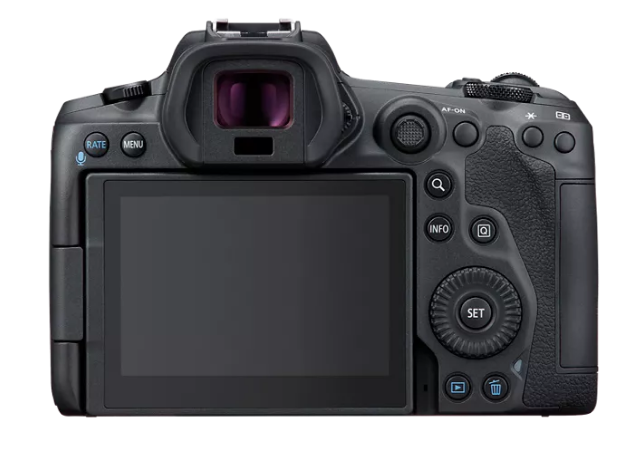Canon EOS R5 vs EOS R6 Mark II:Which Is More Worth Buying?
Tuesday 21 May 2024
 5.9k
5.9k
 Reproduction without the author's authorization is prohibited
Reproduction without the author's authorization is prohibited
Canon EOS R5 and EOS R6 Mark II are both full-frame cameras launched by Canon. Although there is not much difference in appearance between the two cameras, there is a big difference in price between the two cameras.
What causes the huge difference in price? Does their image quality make such a big difference in price? Please keep reading.
Body


front view
If you put the two cameras in their front view, you will find that the two machines are very similar. The front of the EOS R6 Mark2 will be relatively flat. This is because the EOS R5 has a remote port flap, but the EOS R6 Mark 2 does not. And the EOS R6 Mark 2 has some plastic components on the front, while the EOS R5 is rubber.


top view
Looking at the top of the two cameras, there are significant differences between the two cameras. The most obvious difference is that the Canon EOS R5 has a digital top LCD screen. This LCD screen allows users to quickly view relevant information when shooting from a low position or checking parameters. The R6 Mark 2 has a traditional PASM dial in the same position.


back view
Looking at the back view, the biggest difference is the size of the LCD. The EOS R5 has a 3.2″ Diagonal LCD, while the EOS R6 has a 3.0″ Diagonal LCD. Otherwise, the button layout of the two cameras is basically the same.
If you think these two top full-frame cameras are too professional, you can also check out Canon’s entry-level models:Canon Eos R50 VS R100:Which Is Better?
sensor
Canon EOS R6 Mark II Sensor
Resolution: 24.2 megapixels
Sensor Type: Full-frame CMOS
Low-Light Performance: Excellent due to lower resolution, resulting in larger pixel size
Dynamic Range: Very good, but slightly less than the R5 due to lower resolution
Target Use: Versatile for various types of photography, particularly beneficial for low-light situations, action, and sports photography due to potentially better high ISO performance and faster readout speeds.
Canon EOS R5 Sensor
Resolution: 45 megapixels
Sensor Type: Full-frame CMOS
Low-Light Performance: Very good, but higher resolution can mean smaller pixel size, which might impact high ISO performance slightly
Dynamic Range: Excellent, with higher resolution providing more detail and flexibility in post-processing
Target Use: Ideal for high-resolution applications such as landscape, studio, and commercial photography where detail is paramount. Also supports 8K video recording, which is beneficial for videographers needing ultra-high resolution video.
viewfinder
The Canon R5 has a significantly higher resolution viewfinder (5.76 million dots) compared to the R6 Mark II (3.69 million dots). This means the R5 provides a clearer and more detailed view, which can be particularly beneficial for critical focusing and checking fine details in your composition.
iso
Canon EOS R6 Mark II offers a native ISO range of 100-102,400, expandable to 204,800. Canon EOS R5 has a native ISO range of 100-51,200, expandable to 102,400.the Canon EOS R6 Mark II generally offers better high ISO performance compared to the Canon EOS R5 due to its lower resolution sensor, which results in larger pixels and better low-light sensitivity. However, the R5 provides higher resolution for applications where detail is paramount.
continuous shooting
Canon EOS R6 Mark II (R6 II) Continuous Shooting:
Mechanical Shutter: Up to 12 frames per second (fps).
Electronic Shutter: Up to 40 fps.
Buffer Capacity: Capable of sustaining high-speed shooting for a significant number of shots, especially in JPEG format, making it suitable for capturing fast-moving subjects without missing crucial moments.
Canon EOS R5 Continuous Shooting:
Mechanical Shutter: Up to 12 fps.
Electronic Shutter: Up to 20 fps.
Buffer Capacity: While offering high-speed continuous shooting, the R5’s buffer may fill up faster due to the larger 45 MP files, which are more demanding on memory and processing.
Comparative Analysis:
Speed: The R6 II takes the lead with its remarkable 40 fps using the electronic shutter, which is significantly higher than the R5's 20 fps. This makes the R6 II exceptionally well-suited for capturing very fast action sequences.
Buffer Capacity: Both cameras have excellent buffer capacities, but the R6 II may have an advantage due to its smaller file sizes (24.2 MP vs. 45 MP), allowing it to sustain high-speed bursts for longer periods.
Shutter Mechanisms: Both cameras offer the same speed (12 fps) with the mechanical shutter, which is useful for scenarios where avoiding rolling shutter distortion is critical.
In terms of continuous shooting, the Canon EOS R6 Mark II outperforms the Canon EOS R5 due to its higher electronic shutter speed of up to 40 fps compared to the R5’s 20 fps. This makes the R6 II the better choice for photographers who need extremely high burst rates to capture fast-moving subjects.
Autofocus
Canon EOS R6 Mark II (R6 II) Autofocus:
AF System: Dual Pixel CMOS AF II with up to 1053 AF points.
AF Coverage: Approximately 100% of the frame.
AF Speed: Very fast and responsive, with improved algorithms for better subject tracking and recognition.
AI-driven Subject Detection: Enhanced animal, human, and vehicle detection, including advanced head, face, and eye detection.
Low-Light AF: Excellent performance, capable of focusing in very low light conditions (down to -6.5 EV).
Canon EOS R5 Autofocus:
AF System: Dual Pixel CMOS AF II with up to 1053 AF points.
AF Coverage: Approximately 100% of the frame.
AF Speed: Fast and accurate, similar to the R6 II, with robust subject tracking and recognition.
AI-driven Subject Detection: Advanced animal, human, and vehicle detection, including head, face, and eye detection, similar to the R6 II.
Low-Light AF: Strong low-light performance, capable of focusing down to -6 EV.
Comparative Analysis:
AF Points and Coverage: Both cameras offer the same number of AF points and similar frame coverage, providing extensive and precise autofocus capabilities across the frame.
Subject Detection: Both models feature advanced AI-driven subject detection, which includes humans, animals, and vehicles. However, the R6 II has slightly updated algorithms that might provide a marginal improvement in tracking moving subjects, especially in challenging conditions.
Low-Light Performance: The R6 II has a slight edge in low-light autofocus performance, with the ability to focus in conditions as low as -6.5 EV compared to the R5’s -6 EV. This difference, while minor, could be significant in very dark environments.
Real-World Use: In practical terms, both cameras offer exceptional autofocus performance suitable for a wide range of photography, including sports, wildlife, and portraiture. The improvements in the R6 II are incremental, so for most users, the difference may not be dramatically noticeable.
video
Canon EOS R6 Mark II (R6 II) Video Capabilities:
Resolution and Frame Rates:
4K up to 60p, oversampled from 6K for improved detail and reduced moiré.
Full HD (1080p) up to 120p for high-quality slow-motion footage.
Recording Limits:
Significantly improved thermal management over its predecessor, allowing for longer recording times without overheating.
No 30-minute recording limit for 4K 30p and lower frame rates.
conclusion
The Canon EOS R5 generally surpasses the EOS R6 Mark II in terms of resolution, offering a 45-megapixel sensor compared to the R6 II's 24.2-megapixel sensor, making it a better choice for photographers who need higher detail and large prints. The R5 also excels in video capabilities, supporting 8K recording. However, the R6 II has advantages such as improved low-light performance and a more affordable price point, making it a strong contender for those who prioritize budget and versatility. Ultimately, the choice depends on whether your primary focus is on high resolution and advanced video features (R5) or cost-effectiveness and low-light shooting (R6 II).
Statement: all contents and remarks made by K&F CONCEPT 's intranet friends only represent themselves and do not reflect any K&F CONCEPT 's opinions and views.
-
 Canon will officially release the EOS R6 III on November 6thThursday 30 October 2025
Canon will officially release the EOS R6 III on November 6thThursday 30 October 2025 -
 Sigma 200mm F2 DG OS Lens Patent PublicatedWednesday 29 October 2025
Sigma 200mm F2 DG OS Lens Patent PublicatedWednesday 29 October 2025 -
 How to Shoot Vintage Halloween PhotosTuesday 28 October 2025
How to Shoot Vintage Halloween PhotosTuesday 28 October 2025 -
 Ricoh announced 2 new models October 21stMonday 27 October 2025
Ricoh announced 2 new models October 21stMonday 27 October 2025 -
 Canon EOS R7 Mark II Camera to be Released in 2026Friday 24 October 2025
Canon EOS R7 Mark II Camera to be Released in 2026Friday 24 October 2025








